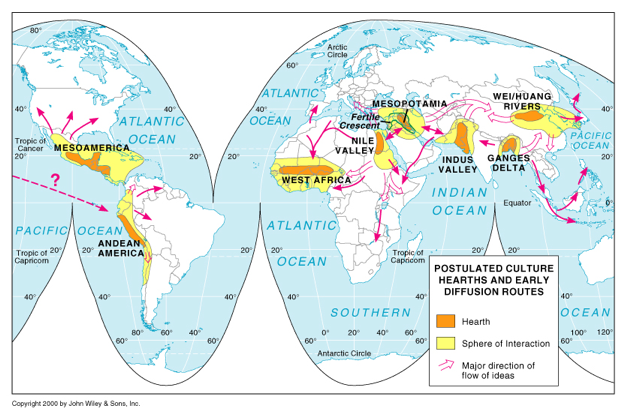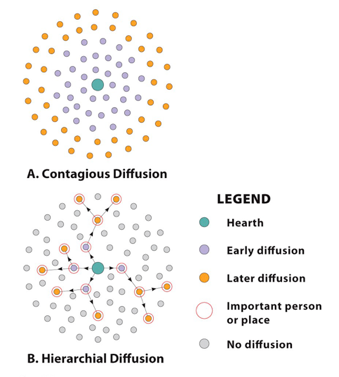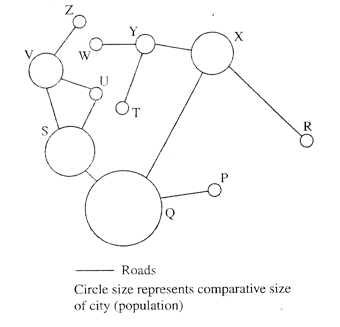- Location
- Human/Environmental Interactions
- Regions
- Place
- Movement
The first three themes come from Pattison's four traditions: Location, human/environmental interactions, and regions.
Two other themes, place and movement, were added in 1986 by the National Geographic society developed by the Geography Education National implementation Project (GENIP): all places on earth have distinguishing human and physical characteristics; movement pertains to people, goods, and ideas.
Theme 1. Location
- a location is a space: everything has a position, a location, on, below, or above the Earth's surface.
- there are several ways to indicate location:
- Maps:
- maps are probably the best way to show the location of objects or people
- maps also show the relationship between one location and another
- all maps have distortion
- there are many types of map—in the AP Human Geography course, we focus on a handful
- Place-name or toponym
- a name given to a portion of the Earth's surface, like "Miami"
- Miami, however, as a "place" is at the same time a space, but also a region, in a sense—people from Homestead to Aventura, and even people from Broward or Palm Beach may tell people from another part of the world that they live in "Miami" because its more well-known than, say, Coral Gables, or Hialeah
- Site
- physical characteristics of a place
- climate
- water sources
- topography
- soil
- vegetation
- latitude
- elevation
- physical characteristics of a place
- Absolute location
- latitude and longitude (parallels and meridians)
- other indexing system, such as on the map of Spain
- Relative location
- location of a place relative to other, more familiar places (situation or situated)—"Aventura is located a few miles north of the city of "Miami"
- centrality, is a key concept— a center of business, industry, communications, or transportation
- Distribution
- arrangement of something across Earth's surface—various locations of a collection of people or objects
- Density
- frequency with which something occurs in an area
- Arithmetic density: total number of objects (such as people) in an area
- Physiologic density: number of people per unit area of agriculturally productive land
- frequency with which something occurs in an area
- Concentration
- The extent of a feature's spread over an area
- Clustered—relatively close
- Dispersed—relatively far apart
- The extent of a feature's spread over an area
- Pattern
- A generally regular, geometric arrangement of objects
- Maps:
Theme 2. Human/Environmental Interactions
- Cultural ecology means the relations between cultures and the Earth's environment
- Cultural landscape
- the sum total of all changes to the Earth and its biosphere that people make
- land use, commerce, agriculture
- agriculture
- religious buildings
- art in public places
Carl Sauer: "… the forms superimposed on the physical landscape by the activities of man."
- the sum total of all changes to the Earth and its biosphere that people make
Theme 3. Region
Regions (areas of unique characteristics, ways of organizing people geographically)
- Distinctive characteristics:
- area: defined spatial extent
- location: lie somewhere on Earth's surface
- boundaries: sometimes evident on the ground, often based on specifically chosen criteria
- distinctiveness:
- culture (language, ethnicity, race, religion)
- economic activity (agriculture, industry)
- physical conditions (climate, vegetation)
- Three types of regions:
- Formal—visible and measurable homogeneity
- scale matters—Florida is in the United States, and is presumed to be an English-speaking country, but there are places where other languages are dominant in Florida. These places are sub-regions
- Functional—product of interactions, and movement of various kinds, usually characterized by a core and hinterland (e.g. a city and its surrounding suburbs that have communications networks (TV, radio, newspaper) and transportation systems (mass transit and wide, paved roads)
- Vernacular— primarily in the minds of people (e.g. Sunbelt, Deep South or "Dixie")
- Regions can be hierarchical (ordered vertically by size: "Miami", "South Florida", "The Sunbelt"
- Formal—visible and measurable homogeneity
- Regions exist at many scales
- scale of analysis: ruth is scale dependent, phenomena you study at one scale (e.g. local) may well be influenced by developments at other scales (e.g. regional, national, or global)
Theme 4. Place
- the distinctive identity of a space
- shaped by the physical environment, or the ecology, of a space
- shaped by the changes humans have made to that space
- shaped by the interconnections (or lack thereof) among people and objects in a space
- segregation prohibits connections between people
- landforms present physical barriers
- infrastructure facilitates interconnections
- Culture—people's lifestyles, values, beliefs, and traits
- What people care about:
- language
- religion
- ethnicity
- What people take care of:
- daily necessities of survival (food, clothing, shelter)
- leisure activities (artistic expressions, recreation)
- What people care about:
- Cultural institutions: political institutions (a country, its laws and rights)
- Components of culture:
- Culture region—the area within which a particular culture system prevails (dress, building styles, farms and fields, material manifestations,…)
- Culture trait—a single attribute of culture
- Culture complex—a discrete combination of traits
- Culture system
- grouping of certain components of culture—based on ethnicity, language, religion, others
- Culture realm
- An assemblage of culture (or geographic) regions, the most highly generalized regionalization of culture and geography (e.g. sub-Saharan Africa)
- Physical Processes
- Environmental processes, which explain the distribution of human activities
- Climate—long-term average weather condition at a particular location. Vladimir Koppen's five main climate regions (expresses humans' limited tolerance for extreme temperature and precipitation levels)
- Vegetation—plant life.
- Soil—the material that forms Earth's surface, in the thin interface between the air and the rocks. Erosion and the depletion of nutrients are two basic problems concerning the destruction of the soil.
- Landforms
- Earth's surface features (geomorphology) can limit population
- extremes of cold, heat, altitude
- isolation
- physical size, e.g. small islands
- Earth's surface features (geomorphology) can limit population
Theme 5. Movement
- Movement means literally moving people or objects or ideas from one location to another
- Culture Hearths
- Sources of civilization from which an idea, innovation, or ideology originates (e.g. Mesopotamia, Nile Valley)
- Viewed over the passage of time as well as changes in space

- Culture Hearths
- It implies (requires) interconnections and interactions between different locations (diffusion)
- The distances among places
- The accessibility of places
- The transportation and communication connectivity among places
- There are a number ways diffusion can take place, and, often, not only one means if taking place, but rather multiple means
- Cultural diffusion

- spread of an innovation, or ideology from its source area to another culture
- Expansion diffusion—an innovation, or ideology develops in a source area and remains strong there while also spreading outward
- Contagious diffusion—nearly all adjacent individuals are affected (e.g. spread of Islam, disease)
- Hierarchical diffusion—the main channel of diffusion some segment of those who are susceptible to (or willing to adopt) what is being diffused (use of fax machines, cell phones, smart phones, name brands)
- Stimulus diffusion—spread of an underlying principle (e.g. idea of industrialization); not all ideas can be readily and directly adopted by a receiving population; yet, these ideas can still have an impact.
- Relocation diffusion—spread of an innovation, or ideology through physical movement of individuals (Occurs most frequently through migration Involves the actual movement of individuals who have already adopted the idea or innovation, and who carry it to a new, perhaps distant, locale, where they proceed to disseminate it)
- Migrant diffusion—when an innovation originates somewhere and enjoys strong-but brief-adoption, loses strength at origin by the time it reaches another area (e.g. mild pandemics)
- Acculturation—when a culture is substantially changed through interaction with another culture
- Transculturation—a near equal exchange between culture complexes
- Forces that work against diffusion

- Time-distance decay—the more time it takes to go from one place to another and the more distance between one place and another, the less likely people and goods will get there or ideas can have influence
- Physical barriers— what might separate city "U" from city "T"?
- Cultural barriers
- Cultural norms: prevailing attitudes, for example, the role of women or "gendered space"
- Taboos: prohibitions
